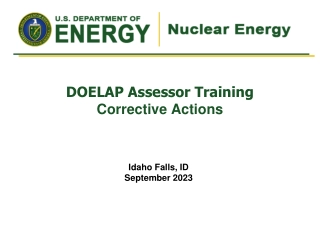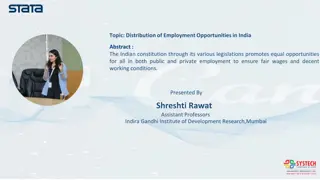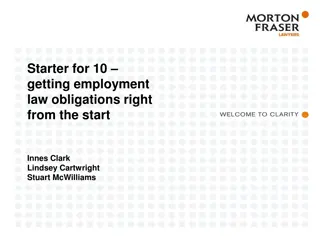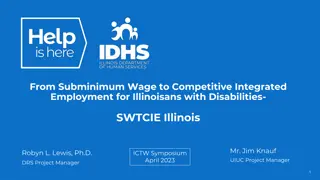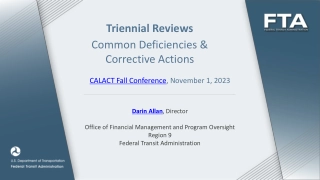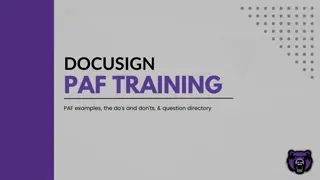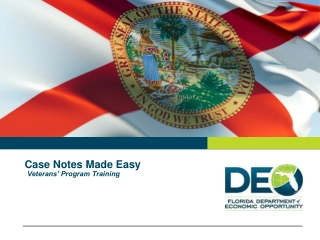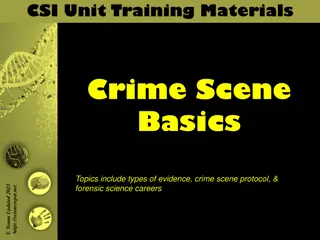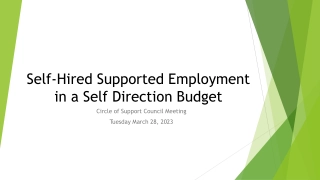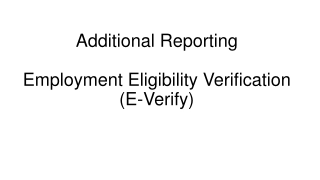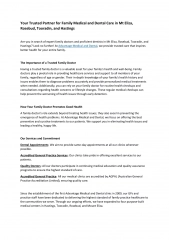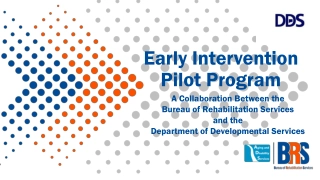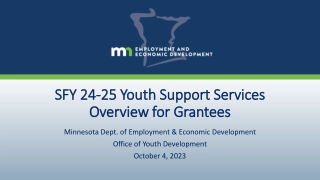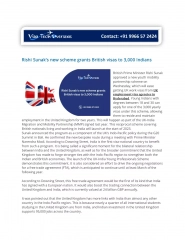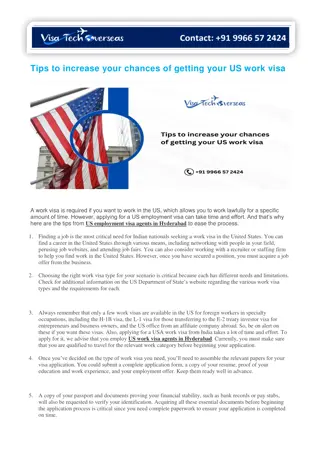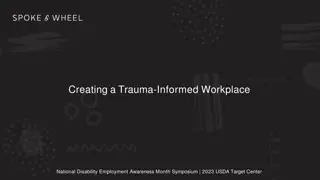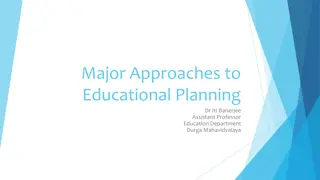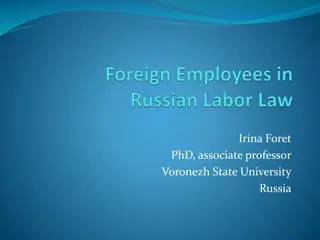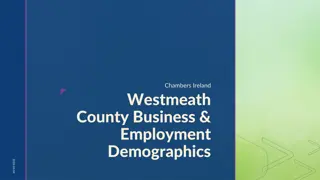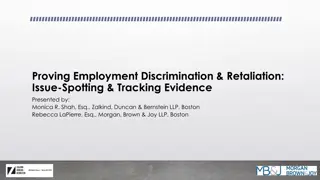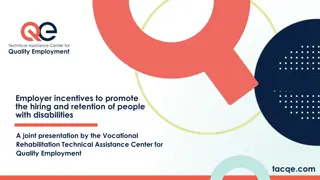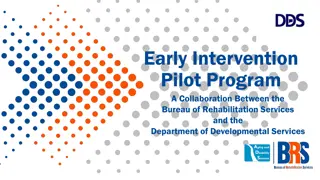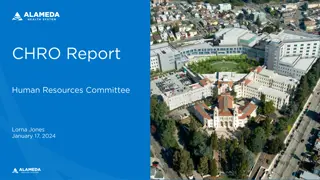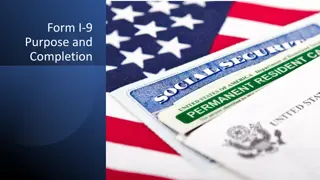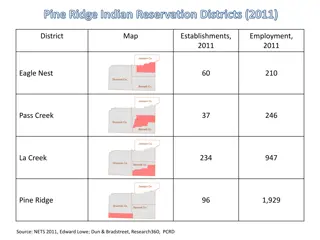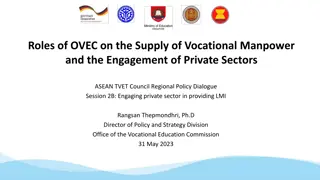Importance of Documenting Employment Actions
Good documentation in employment is crucial for creating a record of actions taken by employers, informing employees of expectations and consequences, serving as evidence in legal claims, and guiding future behavior. This presentation outlines types of documentation, reasons for its importance, implications of not documenting, and when to consult HR.
Importance of Documenting Employment Actions
PowerPoint presentation about 'Importance of Documenting Employment Actions'. This presentation describes the topic on Good documentation in employment is crucial for creating a record of actions taken by employers, informing employees of expectations and consequences, serving as evidence in legal claims, and guiding future behavior. This presentation outlines types of documentation, reasons for its importance, implications of not documenting, and when to consult HR.. Download this presentation absolutely free.
Presentation Transcript
Documenting Employment Actions
WELCOME! 2
Introduction The goal of good documentation is to create a record of employment, including facts of incidences and the steps and actions by the employer in an employment matter. Effective documentation serves as an aid to future managers and HR professionals for historical perspective, audits and legal claims. This presentation provides you, as supervisors, with information on what and how to document as well as the importance of good employment documentation. 3
Agenda Types of documentation Reasons documentation is important Effective vs ineffective documentation Implications of not documenting Employment actions that require documentation When to consult with HR What and how to document 4
Types of Documentation Handwritten or typed notes from coaching and counseling sessions with employees. Follow-up email summarizing a performance discussion meeting. Written comments including specific examples in performance reviews. Disciplinary actions, such as warning documents with specific examples and consequences. Handwritten or typed explanations with business reasons for employment actions such as demotions, promotions and layoffs. 5
Reasons Documentation Is Important Establishes a record of employment actions taken and the reasons for the actions. Memories fail, managers move on, and other circumstances change. Informs employees of what is expected of them and the consequences if they do not meet expectations. Employees should never be surprised if termination becomes necessary. 7
Reasons Documentation Is Important (cont.) Serves as evidence of the employer s business reasons for actions taken, in the event an employee takes formal or informal steps with a claim against a manager or employer. From a performance management standpoint, it serves as a written record to guide both the employer s and the employee s future behavior. It gives the employee the opportunity to improve. 8
Effective vs Ineffective Documentation Effective documentation will generally include: The employer s expectation. How the employee has failed to meet that expectation. Reference to prior counseling or discipline. The employer s expectations for the employee going forward. The consequences of the employee s failure to make the requisite improvement. 10
Effective vs Ineffective Documentation Common disciplinary documentation mistakes include: Using labels without providing behavioral examples. Using words that sound like proxies for bias or retaliation. Focusing on the employee s intent (as opposed to results). Focusing on the perceived cause of a performance problem as opposed to the problem itself. Using absolutes that are not credible (e.g., always and never). Including everything an employee has ever done wrong/overkill. Failing to make clear the consequences of lack of improvement. 11
Effective vs Ineffective Documentation Seven rules for creating bulletproof documentation: 1. Describe company expectations. Clearly state what the job description or the company policies require. Describe the behavior or performance that must change (or that you want to continue). Describe the conduct, not the individual. Include the employee s explanation for why expectations aren t being met. Having a two-way conversation shows the manager s attempt to be fair and learn how to help the individual. Prepare a detailed action plan that the employee should use to improve performance. Include specific steps the employee will take to improve and what you will do to help. 2. 3. 4. 12
Effective vs Ineffective Documentation Seven rules for creating bulletproof documentation (cont.): 5. Set deadlines for correcting the behavior or performance. Be specific, say, We expect your report will be turned in by 5 p.m. tomorrow. 6. Describe the consequences if the behavior or poor performance continues. 7. Avoid vague phrases that could provide grounds for discrimination lawsuits. Don t terminate someone for a bad attitude or because he isn t a good culture fit. Those are red flags that could cause the employee to believe the firing is attributable to gender, race or national origin or to the employee s membership in another group protected under federal, state or local civil rights laws. 13
Implications of Not Documenting Performance or attendance does not improve, and there are negative impacts to business, morale and eventually the manager s own performance. Increased frustration by manager and co-workers. Misunderstandings or interpretation of a discussion. Employees not treated equitably or fairly. Lack of documented formal evidence for defense in the event of legal claims. 15
Employment Actions that Require Documentation Setting and revising annual performance goals and objectives. Midyear and annual performance reviews. Violation of company policy, procedure, practice or code of conduct. Attendance issues. Poor performance. Safety violations. Investigations. 16
Employment Actions that Require Documentation (cont.) Demotions. Promotions. Change in job duties. Training needs and accomplishments. Bonus and merit increase decisions. Placing an employee on probation. Suspension. Termination. 17
When to Consult with HR Accommodations religious and medical. Requests for family or medical leave. Significant changes to job duties. Demotions. Promotions. Harassment or discrimination claims. Final written warning. Egregious code of conduct or policy violations. Layoffs. Terminations. 19
What and How to Document For general attendance and performance concerns, and minor policy violations: Follow the company discipline policy. Discuss an employee s performance with the employee continuously as part of the performance management process. Document the issue timely. Document only the facts, not subjective judgments or conclusions. Be thorough and avoid company jargon and assumptions. Make notes in writing. Include when (date and time), who was present, what was discussed, the employee s response, and the outcome, including a date for a follow-up meeting. 21
What and How to Document (cont.) For formal written warnings: Use the company provided template. Cite examples of how the employee has not met performance or attendance expectations. Give specific guidance for improving performance or attendance. Describe the consequences of continued failure to meet expectations. Have a face-to-face discussion (whenever possible) with the employee and review the warning document in detail. 22
What and How to Document (cont.) For formal written warnings (cont.): Have the employee sign the warning to acknowledge the discussion and confirm the receipt and understanding of the document. Document the discussion from the discipline meeting in writing and attach to the warning document. Give a copy of the warning documents to HR. Discuss any issues that came up during the discipline meeting with HR. 23
Summary Documentation is important for both the employer and the employee. Good documentation answers the questions who, what, where, and when. Document early. Do not wait. Discussion without documentation equals misunderstandings. Discuss and document only the facts. 25
Summary (cont.) Give specific examples for how the employee is not meeting expectations and specific guidance for how the employee can improve. Always consult with HR about matters concerning FMLA, ADA, harassment claims, final warnings and terminations. Ask the employee to sign documentation of disciplinary actions. Give a copy of the disciplinary action to HR and the employee. Discuss any issues arising from the meeting with HR. 26
Training Evaluation Please complete the training evaluation sheet included in the handouts. Thank you for your interest and attention! 28


